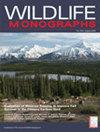Behavior, energetics and management of refuging waterfowl: a simulation model
IF 3.8
1区 生物学
Q1 ECOLOGY
引用次数: 29
Abstract
A stochastic simulation model, designed to test the effects of alternative management schemes on refuging waterfowl populations, was constructed from data on fall-migrating lesser snow geese (Chen c. caerulescens) at the DeSoto National Wildlife Refuge, Iowa. Components of the model include goose population level, food density and distribution, food-searching flight characteristics, feeding rates, activity and energy budgets, migration rates, and the effects of weather, hunting pressure, and land management practices on the system. Independent data were collected to test the model's validity. The model validly describes movement from the refuge core to distant feeding areas, and it provides insight into factors affecting emigration. Refuge population level was not sensitive to shifts (?20%) in the input values of 25 selected parameters, but hunting mortality and daily foraging distances were sensitive to several combinations of parameter perturbations. Model outcome was most sensitive to changes in digestive efficiency, mean food density, and the proportion of refuge fields in which food was available. In other model experiments, increased hunting pressure caused significant (P < 0.05) increases in hunting mortality and a reduction in the refuge population. The direct effect of hunting was less important in reducing waterfowl population size than the associated disturbance of feeding geese by hunters, which reduced energy gains and subsequently hastened emigration. Geese in the vicinity of the DeSoto Refuge feed almost exclusively on waste corn. Simulated hunting mortality increased significantly (P < 0.0001) when waste-corn density was moderately reduced because increased goose movement resulted in more shooting opportunities for hunters, but, at extremely low levels of food density, refuge use by waterfowl declined and hunting mortality was reduced. When superabundant food was provided on the refuge, hunting mortality was reduced and waterfowl use of the refuge increased. An artificial reduction in size of the feeding arena, from a radius of 121 km to 8 km, did not affect waterfowl population levels because food supplies were adequate within 8 km of the refuge core. The model can be used to simulate the effects of other management scenarios and is a valuable tool for identifying and meeting management objectives. WILDL. MONOGR. 96, 1-35 Journal Paper J-11908 of the Iowa Agriculture and Home Economics Experiment Station, Ames, Iowa, Project 2427. 2 Present Address: Department of Biological Sciences, Eastern Kentucky University, Richmond, KY 40475. 3 Supported jointly by the U.S. Fish and Wildlife Service, Iowa Conservation Commission, Iowa State University, and Wildlife Management Institute. This content downloaded from 157.55.39.35 on Wed, 31 Aug 2016 04:14:15 UTC All use subject to http://about.jstor.org/terms水禽避难行为、能量学与管理:模拟模型
基于爱荷华州德索托国家野生动物保护区秋季迁徙的小雪雁(Chen c. caerulescens)的数据,建立了一个随机模拟模型,旨在测试不同管理方案对水禽种群的影响。该模型的组成部分包括鹅的种群水平、食物密度和分布、寻找食物的飞行特征、摄食率、活动和能量预算、迁徙率,以及天气、狩猎压力和土地管理实践对系统的影响。收集独立数据来检验模型的有效性。该模型有效地描述了从避难所核心到遥远的喂养区域的运动,并提供了影响移民的因素的见解。避难种群水平对25个参数输入值的变化不敏感(- 20%),但狩猎死亡率和日觅食距离对几个参数扰动组合敏感。模型结果对消化效率、平均食物密度和可获得食物的避难所比例的变化最为敏感。在其他模型实验中,狩猎压力的增加导致了狩猎死亡率的显著增加(P < 0.05)和避难所种群的减少。在减少水禽种群规模方面,狩猎的直接影响不如猎人喂养鹅的干扰重要,后者减少了能量的获得,随后加速了迁徙。德索托保护区附近的鹅几乎完全以废玉米为食。当废玉米密度适度降低时,模拟狩猎死亡率显著增加(P < 0.0001),因为鹅的运动增加了猎人的射击机会,但是,在极低的食物密度水平下,水禽的避难所使用减少,狩猎死亡率降低。当避难所提供了充足的食物时,狩猎死亡率降低,水禽使用避难所增加。人为地将饲养场所的面积从121公里半径缩小到8公里,这并未影响水禽的数量水平,因为在保护区核心8公里范围内食物供应充足。该模型可用于模拟其他管理场景的效果,是识别和实现管理目标的有价值的工具。WILDL。MONOGR。论文J-11908,艾奥瓦州农业与家庭经济实验站,艾姆斯,艾奥瓦州,项目2427。2现址:东肯塔基大学生物科学系,肯塔基州里士满40475。由美国鱼类和野生动物管理局、爱荷华保护委员会、爱荷华州立大学和野生动物管理研究所共同支持。此内容于2016年8月31日星期三04:14:15 UTC下载于157.55.39.35,所有内容以http://about.jstor.org/terms为准
本文章由计算机程序翻译,如有差异,请以英文原文为准。
求助全文
约1分钟内获得全文
求助全文
来源期刊

Wildlife Monographs
生物-动物学
CiteScore
9.10
自引率
0.00%
发文量
3
审稿时长
>12 weeks
期刊介绍:
Wildlife Monographs supplements The Journal of Wildlife Management with focused investigations in the area of the management and conservation of wildlife.
Abstracting and Indexing Information
Academic Search Alumni Edition (EBSCO Publishing)
Agricultural & Environmental Science Database (ProQuest)
Biological Science Database (ProQuest)
CAB Abstracts® (CABI)
Earth, Atmospheric & Aquatic Science Database (ProQuest)
Global Health (CABI)
Grasslands & Forage Abstracts (CABI)
Helminthological Abstracts (CABI)
Natural Science Collection (ProQuest)
Poultry Abstracts (CABI)
ProQuest Central (ProQuest)
ProQuest Central K-543
Research Library (ProQuest)
Research Library Prep (ProQuest)
SciTech Premium Collection (ProQuest)
Soils & Fertilizers Abstracts (CABI)
Veterinary Bulletin (CABI)
 求助内容:
求助内容: 应助结果提醒方式:
应助结果提醒方式:


